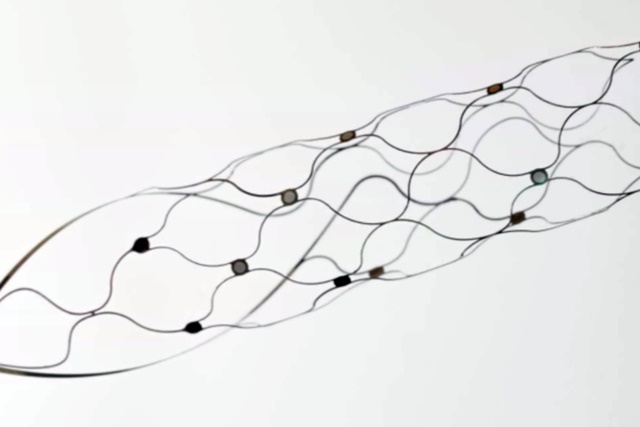30 Mar. 2022. A clinical trial shows an electronic prosthetic device sent into the brain does not cause serious adverse effects after a year in a small group of people with ALS. A team from Synchron Inc. in New York, developer of the device assessed in the trial, and colleagues, will report their findings at an American Academy of Neurology meeting, 2-7 April in Seattle, and later online 24-26 April.
The tested device is called the stentrode, a small metallic wire mesh tube, similar to a stent. It has 16 sensor electrodes on tiny disks inside the tube, placed in a blood vessel adjacent to the primary motor cortex that controls voluntary muscular movements in the body. However, instead of drilling a hole in the skull to implant the device, the electrode travels from a jugular vein in the neck into the selected brain blood vessel. When the stentrode reaches its destination, it expands to fill the blood vessel.
Once implanted, the stentrode captures electric signals directed to the motor cortex to stimulate specific muscles in the body, with Synchon’s brain.io system. The system sends signals from the stentrode to a device implanted under the skin in the patient’s chest called the node that decodes the signals. From the node, says Synchron, signals are translated with algorithms into computer-readable commands by another system component called the axon for communication via Bluetooth to a nearby computer, and eventually to help restore limb functions.
No serious adverse effects reported
The clinical trial is an early-stage study evaluating stentrode’s safety. Four individuals with ALS in Melbourne, Australia were recruited to receive and wear a stentrode for one year. ALS, short for amyotrophic lateral sclerosis, is a progressive neurodegenerative disorder where neurons or nerve cells controlling muscles in the body begin to waste away, and can no longer send or receive signals from the brain or spinal cord. As the nerve cells stop functioning, muscles in the limbs, and later speech and breathing muscles, begin weakening and eventually stop functioning leading to paralysis and death.
The study team looked primarily for signs of adverse effects from the stentrode. After a year, say the researchers, the stentrode remained in place, and participants report no serious adverse effects leading to disability or death. The early findings, reported by Synchron and American Academy of Neurology, did not disclose other less serious adverse effects encountered by the stentrode recipients. The company says during the year the four participants also learned how to use a computer with an eye-tracking device. Science & Enterprise reported on the start of the trial in Sept. 2019.
“Our research is still new,” says Bruce Campbell, professor of neurology at University of Melbourne and a study author in an American Academy of Neurology statement, “but it holds great promise for people with paralysis who want to maintain a level of independence. We are continuing this research in Australia as well as in the United States in larger groups of people.”
“These results are a huge advancement for the field of BCI (brain-computer interface),” adds Synchron co-founder and CEO Thomas Oxley in a company statement released through BusinessWire. “We’ve shown that our endovascular BCI approach is safe, and allows patients to accomplish daily online tasks without invasive brain surgery.”
More from Science & Enterprise:
- Trial Assessing Digital Data for Covid-19 Vaccine Responses
- Virtual Trial to Test Digital Cancer Stress Therapies
- Collaboration to Build Digital Pathology Algorithms
- Digital Neuroscience Companies Partner on AR/AI Diagnostics
- Spinal Fusion/Stimulation Trial for Back Pain Underway
We designed Science & Enterprise for busy readers including investors, researchers, entrepreneurs, and students. Except for a narrow cookies and privacy strip for first-time visitors, we have no pop-ups blocking the page, nor distracting animated GIF graphics. If you want to subscribe for daily email alerts, you can do that here, or find the link in the upper left-hand corner of the desktop page. The site is free, with no paywall. But, of course, donations are gratefully accepted.
* * *


 RSS - Posts
RSS - Posts
You must be logged in to post a comment.